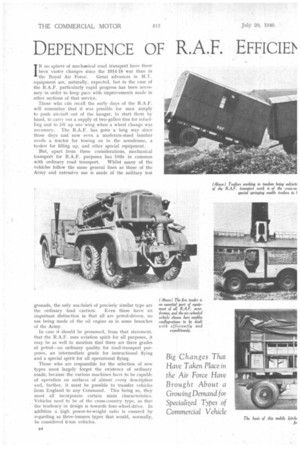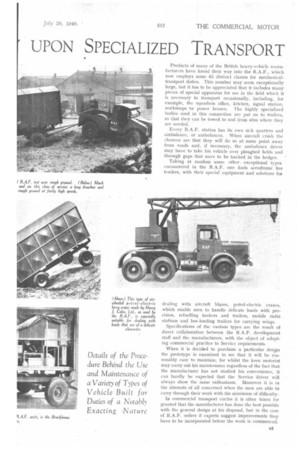DEPENDENCE OF R.A.F. EFFICIEIN UPON SPECIALIZED TRANSPORT
Page 30

Page 31

Page 32

If you've noticed an error in this article please click here to report it so we can fix it.
/N no sphere of mechanical road transport have there been vaster changes since the 1914-18 war than in
the Royal Air Force. Great advances in M.T. equipment are, naturally, expected, but in the case of the R.A.F. particularly rapid progress has been necessary in order to keep pace with improvements made in other sections of that service.
Those who ca:h recall the early days of the R.A.F. will remember that it was possible for men simply to push aircraft out of the hangar, to start them by hand, to carry out a supply of two-gallon tins for refuelling and to lift up one wing when a wheel change was necessary. The R.A.F. has gone a long way since those days and now even a moderate-sized bomber needs a tractor for towing on to the aerodrome, a tanker for filling up, and other special equipment.
But, apart from these considerations, mechanical transport for R.A.F. purposes has little in common with ordinary road transport. Whilst many of the vehicles follow the same general lines as those of the Army and extensive use is made of the military test grounds, the only machines of precisely similar type are the ordinary load carriers. Even these have an important distinction in that all are petrol-driven, no use being made of the oil engine as in some branches of the Army.
In case it should be presumed, from that statement, that the R.A.F. uses aviation spirit for all purposes, it may be as well to mention that there are three grades of petrol—an ordinary quality for road-transport purposes, an intermediate grade for instructional flying and a special spirit for all operational flying.
Those who are responsible for the selection of new types must largely forget the existence of ordinary roads, because the various machines have to be capable of operation on surfaces of almost every description and, further, it must be possible to transfer vehicles from England to any Command. This being so, they must all incorporate certain main characteristics. Vehicles need to be of the cross-country type, so that the tendency in design is towards four-wheel-drive. In addition a high power-to-weight ratio is ensured by regarding as three-tonners types that would, normally, be considered 6-ton vehicles_ Products of many of the British heavy-vehicle manufacturers have found their way into the R.A.F., which now employs some 65 distinct classes for mechanicaltransport duties. This number may seem exceptionally large, but it has to be appreciated that it includes many pieces of special apparatus for use in the field which it is necessary to transport occasionally, including, for example, the squadron office, kitchen, signal station, workshops or power houses. The highly specialized bodies used in this connection are put on to trailers, so that they can be towed to and from sites where they are needed.
Every R.A.F. station has its own sick quarters and ambulance, or ambulances. When aircraft crash the chances are that they will do so at some point away from roads and, if necessary, the ambulance driver may have to take his vehicle over ploughed fields and through gaps that nave to be hacked in the hedges.
Taking at random some other. exceptional types encountered in the R.A.F. one finds aerodrome fire tenders, with their special equipment and solutions for dealing with aircraft blazes, petrol-electric cranes, which enable men to handle delicate loads with precision, refuelling tankers and trailers, mobile radio stations and low-loading trailers for carrying wings.
Specifications of the various types are the result of direct collaboration between the R.A.F. development staff and the manufacturers, with the object of adapting commercial practice to Service requirements.
When it is decided to purchase a particular design the prototype is examined to see that it will be reasonably easy to maintain, for whilst the keen motorist may carry out his maintenance regardless of the fact that the manufacturer has not studied his convenience, it can hardly be expected that the Service driver will always show the same enthusiasm. Moreover it is in the interests of all concerned when the men are able to carry through their work with the minimum of difficulty.
In commercial transport circles it is often taken for granted that the manufacturer has done the best possible with the general design at his disposal, but in the case of R.A.F. orders if experts suggest improvements they have to be incorporated before the work is commenced.
That there shall be no avoidable breakdowns is the essence of R.A.F. transport operations. A convoy is merely as good as its weakest machines, because the 20 or so vehicles that arrive are of little value if the one that contains some essential part has broken down.
When a new design is being added to the list it is examined at the factory, in conjunction with the manufacturers' representatives and plans are drawn up for future maintenance. Plans are made for the range of spares likely to be required and the most suitable class of men to be allocated for duties in connection with the machine's operations.
In general, all machines get a daily inspection with more detailed attention at 500-mile, 2,000-mile and 6,000-raile intervals. One make of vehicle requires decarbonizing at 6,000 miles, but the rest run between 8,000 and 20,000 miles before this operation becomes necessary. For the purposes of full overhaul vehicles are transferred, in turn, to a main depot, but all other attention is carried out at the machine's own station.
A branch of R.A.F. activity that has been largely in the public eye since the outbreak of war is the balloon barrage, for the efficient maintenance of which road motors in a variety of usual and unusual forms find a number of invaluable uses. This phase was covered in an article appearing in our issue dated June I last, when the highly developed transport organization behind the working and control of the barrage was dealt with at length. In the establishment and maintenance of this vital branch motor vehicles and trailers are playing an important part in the measures taken for home defence.
Although mechanical transport is definitely an "overhead charge" in the R.A.F. it is an undoubted essential to the work of a service which has inspired many new developments in connection with ground transport.




























































